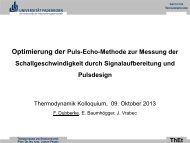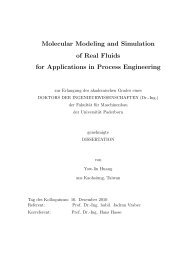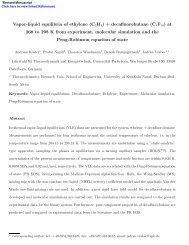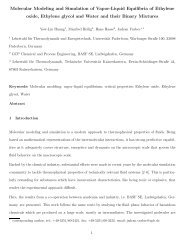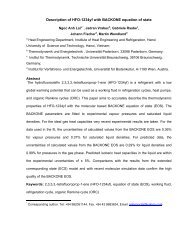ms2: A Molecular Simulation Tool for Thermodynamic Properties
ms2: A Molecular Simulation Tool for Thermodynamic Properties
ms2: A Molecular Simulation Tool for Thermodynamic Properties
You also want an ePaper? Increase the reach of your titles
YUMPU automatically turns print PDFs into web optimized ePapers that Google loves.
3. Modular structure - example<br />
The modular structure of <strong>ms2</strong> is discussed by highlighting a MD simulation calculation process of a pure fluid<br />
modeled by two LJ sites and two point charges in the NVT ensemble. During the initialization process, the<br />
modules <strong>for</strong> memory allocation and definition of the simulation scenario are executed. This process is not unique<br />
<strong>for</strong> any of the hierarchical levels, but takes places on all levels, cf. Figure 4 in the associated paper.<br />
On level one, the simulation is delimited to ”molecular dynamics”, there<strong>for</strong>e all modules concerning MC sim-<br />
ulation are entirely neglected. On level two, the ”initialization” modules define the simulation environment by<br />
setting ensemble specific properties, like simulation volume, temperature as well as the thermostat and integration<br />
algorithm etc. While the use of the first modules mentioned above is required in each simulation, independently<br />
of MD or MC, e.g. the trajectory calculation is specific <strong>for</strong> MD. However, the modular structure retains the ef-<br />
ficiency of the program by initiating only the molecule propagation that is specific <strong>for</strong> the simulation technique.<br />
The same effect of modules can be found in the initiation process on lower levels. Here, the composition of<br />
the molecular species in the simulation volume (module component), the description of the molecule (module<br />
molecule) and the storage of the positions, velocities and <strong>for</strong>ces of all LJ sites and charges (module sites) are<br />
determined. All other modules, e.g. treating additional components <strong>for</strong> mixtures or containing characteristic<br />
properties of dipoles or quadrupoles, are fully omitted by <strong>ms2</strong> in this case, because they are not needed in this<br />
simulation. Once the simulation has been initialized, a set of modules is invoked, which deals with maintaining<br />
the simulation run. On level one, this includes modules of global use <strong>for</strong> any simulation, e.g. limiting the exe-<br />
cution time etc. On level two, Newton’s equations of motion are numerically integrated, requiring in<strong>for</strong>mation<br />
about the fluid’s composition, the positions and orientations of the molecules etc. provided by modules of the<br />
respective level. The thermostat is applied and the calculation of thermodynamic properties is per<strong>for</strong>med. The<br />
<strong>for</strong>ces, torques and energies are calculated in the second branch on the level component. For a MD simulation,<br />
this covers routines <strong>for</strong> the calculation of energies as well as <strong>for</strong>ces at the same time, whereas <strong>for</strong> a MC sim-<br />
ulation, the modules only calculate energies and virial contributions. A further set of modules deals with the<br />
accumulation of data. These modules are designed to store data and evaluate the statistics of the produced data.<br />
The actual thermodynamic properties are calculated on the ensemble level. The last set of modules deals with the<br />
output, where the results of the molecular simulation are written to file. These modules are called independently<br />
on the user settings in all simulation scenarios.<br />
9



